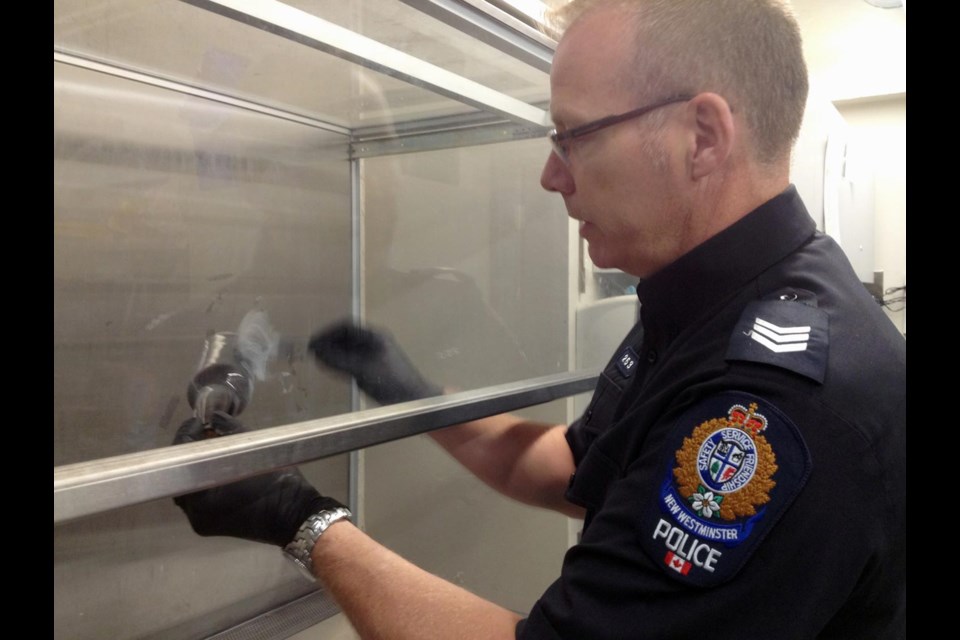Talk about a midlife change.
Former Ottawa Police staff sergeant Dwayne Raymond spent more than 20 years as a police officer, and much of that time was spent perfecting his skills in forensic identification.
But when his family decided to move across the country in 2009 to the Lower Mainland, Raymond was forced to make a drastic career change.
“It was a big decision,” he told The Record. “I was having a great career there (in Ottawa), it’s a great place to work; a good department, a big department. At the time, I was a staff sergeant in charge of a 29-member forensic section.”
The move, however, turned out to be an exciting one, despite the hard work it required of Raymond.
When a police officer moves from one city to another, they don’t get to keep the rank they’ve earned working for a municipal department. So when Raymond left the Ottawa Police he lost his rank of staff sergeant, which meant that when he was hired with the New Westminster Police Department he started from the bottom, as a constable.
“It’s daunting, especially after that amount of time,” he said. “But the one thing I’ve never been afraid of is to try new things. … So starting over again, I just took it as a challenge, and it went very well.”
Raymond spent seven months on patrol, but in 2010 he was called upon to help New West’s busy forensic identification section. Raymond was transferred in on a temporary basis, and he’s never left.
“That went very well and they (the department) decided to keep me up here,” he said. “In the beginning of 2011, they made me an acting sergeant and put me in charge of the section, and that’s sort of the position I’ve been in ever since.”
As the acting sergeant of the forensics section, Raymond is in charge of two full-time officers, a third in training, and he has hopes the department will soon approve a fourth. This section is definitely a much smaller version of what he was used to work with in Ottawa, but it’s just as capable, Raymond said.
“When I came here, I saw an opportunity to take a section that I felt was underused and probably not doing as much as they could be doing within the community and try and make it a better section. Something that was more of an (integral) and invaluable partner within the department,” he said.
Having spent seven months on the front line as a patrol officer in New Westminster, Raymond had seen the work of the forensic section from the outside. He felt the team could be doing more to help solve crimes, so when he took over he made some immediate changes to develop the small section.
“Trying to do more with the bodies that we had at the time, … trying to attend more calls, to do more at the calls, to attend calls that they weren’t attending previously,” he said.
By involving itself in more cases within the department, Raymond felt the forensic section could gain a better understanding of who was committing crime in New Westminster, thus beginning to track crime trends and ultimately aiding in the arrest of criminals.
The forensic section employs two methods to identify criminals, DNA and fingerprints. While it may seem old-fashioned, and definitely not up to CSI’s dramatic standards, fingerprinting is his preferred method to identify a perpetrator, Raymond said.
“It’s a fantastic tool for policing,” he said. “I often equate it to doing puzzles. It’s a challenge. It’s very minute, detailed work that requires skill to be good at, but you have to be meticulous about what you’re doing.”
The fingerprints Raymond and his team collect are sent for comparison to B.C. Automated Fingerprint Identification System (AFIS) or the national database also known as AFIS. If the perpetrator of the crime they’re investigating has already been processed for previous crimes, their fingerprints will come back with a match. Otherwise Raymond must wait to get a fingerprint of a suspect.
The fingerprint analysis process is a slow one, Raymond said.
It requires a physical comparison be done and then, when the officer confirms a match, they are required to testify in court.
“We follow very strict processes because … if you identify somebody and give your opinion that that is that person, you’re saying that that person did that crime,” he said.
There can be no mistakes, the officer must be certain of their identification, Raymond added.
DNA is very similar to fingerprinting except every person only has one DNA profile, making it slightly easier to pin down a perpetrator, but that doesn’t mean it’s easier, Raymond said.
“I think the expectations of forensic sections, overall, have gone up simply because of the media relating to forensics,” he said.
Television shows like CSIhave changed the way officers process evidence and have increased expectations simply because their work is so public. Those shows also have a very condensed time frame and the real forensic process takes much, much longer, Raymond added.
As forensic officers attend more and more crime scenes, the New Westminster section continues to be very busy, which makes Raymond really proud of the work he and his team are doing to reduce crime in the city.
“We’re only on the cusp, I think, of doing what we’re capable of doing,” he said.



